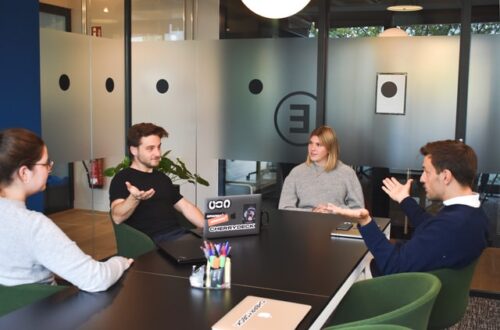What is social cohesiveness? Any team benefits from a healthy amount of social cohesion. It keeps team members comfortable in the presence of their peers enough to openly communicate their ideas, share, honest feedback, and receive constructive criticism.
Social cohesion can be thought of as a glue that binds a team, such as that they help each other achieve a common end. In a cohesive gang, members feel a type of connectedness that stretches beyond office hours as teammates help keep each other’s’ spirits up during challenging tasks and make an active effort to keep everyone on track with regards to their goals.
It’s a beautiful thing to have in the workplace, but it’s more difficult to achieve than it looks. You would’ve had your work cut out for you if you have a homogeneous team. However, these days, that’s quite rare as workplaces have become more diverse and inclusive of individuals from different ethnicities and backgrounds. The upside to a diverse team, though, is the abundance of creative ideas, as everyone has a rich source of lived experience. If, as a leader, you know exactly which direction to steer your team, you can find a unifying ground to which members can come together and work effectively as a team.
4 ways to drive motivation and productive work through social cohesion
Make goals clear. As with other parts of the business, goal-setting cultivates success in the employees’ level as well; especially when it comes to social cohesiveness. Having a clear goal in view unites team members because it allows them to divide tasks according to their strengths and allocate time for planning and execution.
Reward the whole team more than you reward individual employees. While a little competition keeps employees on their toes, competition alone does not improve cohesiveness and may even cause friction between members. Rewarding teams, however, pushes forward the idea that most victories are attained when there’s a collective effort. It also gives people a reason to hold a little get-together after work that may further strengthen their bond.
Hold team-building exercises. A newly formed team may not immediately get into the swing of things and that’s completely normal. One thing you can do, though, to give members the right boost is to send them to team-building activities led by industry experts or human resource officers.
Train your employees for success. It’s much easier to work synergistically when all members know exactly what to do and are leading tasks, they’re good at. Thus, skills training should be an agenda before throwing a team into the deep end of things. Ensure that refresher courses are provided as well so workers can stay up-to-date with the latest development in their field and maintain competence.
Social Cohesiveness & Workplace Safety
Workplace safety is a common goal for all industries, thus it benefits from the cohesiveness of employees all in the same way. For this to be attainable, a special team must be at the forefront actively uniting themselves as well as other units such as that they will be more engaged in upholding health and safety practices.
This team is a WHS Committee.
As mentioned above to nurture cohesiveness and productivity, WHSC’s must undergo training to perform their tasks competently. And we have just what you need to tick this requirement off of your list. And now you can train your WHS Committee for problem solving, effective decision making and effective communication, by assisting them to understand their thinking preferences, and how their thinking preferences impacts their learning, communication, problem solving and decision making.
What is The Herrmann Brain Dominance Instrument – HBDI?
You may know it as the “thinking styles” assessment. For our clients, it is the most powerful and scalable tool they have.
Have you ever thought that perhaps a huge portion of the problems you encounter in the workplace is brought by your employees’ individual differences?
Given their diverse backgrounds and experiences, it’s natural for workers to adapt different ways of looking at things, processing information, and formulating their approach in solving technical problem questions. However, this shouldn’t be where you leave things be. There is a way to champion these differences so as to evoke a synergy that yields profitable outcomes.
Let us break it down for you.
Ned Hermann, the author of the Whole Brain Thinking model®, asserts that by understanding your fundamental thinking style, you come to realise whether it is indeed the best fit for the resolution of any immediate problem. Otherwise, you’re urged to carefully rethink your approach to include other more effective perspectives.
In essence, Ned Hermann believed that people are not confined to a singular thinking style. In fact, he theorised that there are four major thinking domains that everyone can possess a certain level of. It’s only that one or two of these thinking styles take the reins and drive our thought processes.
These domains are as follows:
A- Logical, analytical, fact-based, quantitative
B- Organized, sequential, planned, and detailed
C- Interpersonal, feeling-based, kinesthetic, emotional
D- Holistic, intuitive, integrating, synthesizing
Right off the bat, which of these resonate with you the most?
How do you get an accurate picture of your thinking style?
Simple as this may sound—it all begins with getting to know your dominant thinking style. This is systematically performed by a standardised self-report test called the Herrmann Brain Dominance Instrument (HBDI)®. HBDI measures the level which you are inclined to think in each of the above-mentioned thinking areas. This process is aimed at improving individuals’ self-awareness and ability to adapt one’s thinking to respond to the needs of their team, partners, and consumers. With knowledge of where their decision-making is rooted from, employees are more guided to find unity with others’ ideas to arrive at the best imaginable result.
How does HBDI and Whole Brain Model benefit the WHS Committee?
Better problem-solving techniques. It allows employees to leverage visual, auditory, and other sensory cues that register and resonate the quickest to their colleagues.
Increased teamwork. Understanding their colleagues’ HBDI (Herrmann Brain Dominance Instrument), thinking preferences actively and look for common ground in their identified WHS issues such that they are able to complement rather than clash with each other.
Improved decision-making skills. HBDI broadens a person’s perspective, so they can carefully account for extenuating factors in the success of a WHS project and come up with a balanced and considered verdict for difficulties that may come along.
WHS & Training Compliance Solutions believes that every workplace deserves to enjoy its fullest potential; from the individual level where productivity is launched to the group level where collaborative work drives optimum performance. Whole Brain Model, and HBDI will help you to achieve the full potential.
What is involved?
With the purchase of individual and group thinking preferences assessment.
Initial Information Session. WHS Training and Compliance Solutions will organise an information session with the WHS Committee members and will provide detailed information on HBDI, thinking preferences and Whole Brain Model. The purpose of this information is, Committee members need to understand the purpose and the objective of the HBDI. This will allow the Committee members to answer their questions truthfully.
HBDI tool. WHS Training and Compliance Solutions will provide all WHS Committee members their private Herrmann Brain Dominance Instrument tool
HBDI Individual Consultation Session. WHS Training and Compliance Solutions will provide a private 1-hour session to each member of the WHS Committee through zoom about their individual profiles for their thinking preferences.
WHS Committee Training. Onsite WHS Committee training will be conducted, with the Group HBDI profile.
Group HBDI Profile. WHS Training and Compliance Solutions will provide group HBDI profile to WHS Committee members, and will conduct one of the below training programs:
- Strategic Problem Solving – 4 hours Training
- Strategic Decision Making – 4 hours Training
- Strategic Teamwork -4 hours Training
If your workplace would like to train all three training programs, we will need additional 8 hours for training.
Do you want to learn more about Whole Brain Model, thinking preferences, HBDI?
Contact us for Onsite WHS Committee training, Whole Brain Model and Herrmann Brain Dominance Instrument Consultation.
Sebnem Bulan-Worth Email us your enquiry
Book HBDI Consultation and learn more about our WHSC Training or call 07 5499 2406 to book an appointment with us
Access Work Health and Safety Books from Amazon: Work Health and Safety












